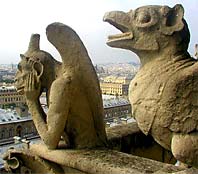 Gargoyles at Notre-Dame, Paris. © Joe & Margaret Chiffriller, Patricia Cramer New York Carver |
|
||
{gahr'-goyl}
Gargoyles are grotesque stone figures most commonly found on Gothic buildings at the roof or eaves (see Gothic art and architecture). Derived from the Old French gargouille (Latin gurgulio), meaning throat or gullet, the term originally meant the unadorned waterspouts that extended outward from a rain gutter or parapet. The gargoyle allowed water to fall free of the walls and foundations, preventing seepage and damage to masonry.
Eventually the spout evolved into a carved head or body with grotesque features, and the term came to designate the figures rather than the spouts. It also was extended to include such figures not used as spouts. Associated primarily with Gothic cathedrals, these figures are sometimes called grotesques.
Superstition held that the gargoyle frightened away evil spirits while serving its practical function. After the introduction of the lead drain pipe in the 16th century, gargoyles primarily served a decorative function.